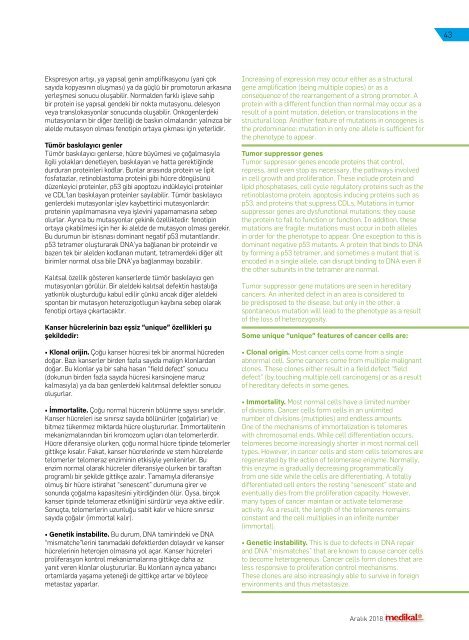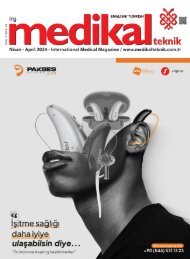Medikal_Aralık_2018
Create successful ePaper yourself
Turn your PDF publications into a flip-book with our unique Google optimized e-Paper software.
43<br />
Ekspresyon artışı, ya yapısal genin amplifikasyonu (yani çok<br />
sayıda kopyasının oluşması) ya da güçlü bir promotorun arkasına<br />
yerleşmesi sonucu oluşabilir. Normalden farklı işleve sahip<br />
bir protein ise yapısal gendeki bir nokta mutasyonu, delesyon<br />
veya translokasyonlar sonucunda oluşabilir. Onkogenlerdeki<br />
mutasyonların bir diğer özelliği de baskın olmalarıdır: yalnızca bir<br />
alelde mutasyon olması fenotipin ortaya çıkması için yeterlidir.<br />
Tümör baskılayıcı genler<br />
Tümör baskılayıcı genlerse, hücre büyümesi ve çoğalmasıyla<br />
ilgili yolakları denetleyen, baskılayan ve hatta gerektiğinde<br />
durduran proteinleri kodlar. Bunlar arasında protein ve lipit<br />
fosfatazlar, retinoblastoma proteini gibi hücre döngüsünü<br />
düzenleyici proteinler, p53 gibi apoptozu indükleyici proteinler<br />
ve CDL’ları baskılayan proteinler sayılabilir. Tümör baskılayıcı<br />
genlerdeki mutasyonlar işlev kaybettirici mutasyonlardır:<br />
proteinin yapılmamasına veya işlevini yapamamasına sebep<br />
olurlar. Ayrıca bu mutasyonlar çekinik özelliktedir: fenotipin<br />
ortaya çıkabilmesi için her iki alelde de mutasyon olması gerekir.<br />
Bu durumun bir istisnası dominant negatif p53 mutantlarıdır.<br />
p53 tetramer oluşturarak DNA’ya bağlanan bir proteindir ve<br />
bazen tek bir alelden kodlanan mutant, tetramerdeki diğer alt<br />
birimler normal olsa bile DNA’ya bağlanmayı bozabilir.<br />
Kalıtsal özellik gösteren kanserlerde tümör baskılayıcı gen<br />
mutasyonları görülür. Bir aleldeki kalıtsal defektin hastalığa<br />
yatkınlık oluşturduğu kabul edilir çünkü ancak diğer aleldeki<br />
spontan bir mutasyon heterozigotlugun kaybına sebep olarak<br />
fenotipi ortaya çıkartacaktır.<br />
Kanser hücrelerinin bazı eşsiz “unique” özellikleri şu<br />
şekildedir:<br />
• Klonal orijin. Çoğu kanser hücresi tek bir anormal hücreden<br />
doğar. Bazı kanserler birden fazla sayıda malign klonlardan<br />
doğar. Bu klonlar ya bir saha hasarı “field defect” sonucu<br />
(dokunun birden fazla sayıda hücresi karsinojene maruz<br />
kalmasıyla) ya da bazı genlerdeki kalıtımsal defektler sonucu<br />
oluşurlar.<br />
• İmmortalite. Çoğu normal hücrenin bölünme sayısı sınırlıdır.<br />
Kanser hücreleri ise sınırsız sayıda bölünürler (çoğalırlar) ve<br />
bitmez tükenmez miktarda hücre oluştururlar. İmmortalitenin<br />
mekanizmalarından biri kromozom uçları olan telomerlerdir.<br />
Hücre diferansiye olurken, çoğu normal hücre tipinde telomerler<br />
gittikçe kısalır. Fakat, kanser hücrelerinde ve stem hücrelerde<br />
telomerler telomeraz enziminin etkisiyle yenilenirler. Bu<br />
enzim normal olarak hücreler diferansiye olurken bir taraftan<br />
programlı bir şekilde gittikçe azalır. Tamamıyla diferansiye<br />
olmuş bir hücre istirahat “senescent” durumuna girer ve<br />
sonunda çoğalma kapasitesini yitirdiğinden ölür. Oysa, birçok<br />
kanser tipinde telomeraz etkinliğini sürdürür veya aktive edilir.<br />
Sonuçta, telomerlerin uzunluğu sabit kalır ve hücre sınırsız<br />
sayıda çoğalır (immortal kalır).<br />
• Genetik instabilite. Bu durum, DNA tamirindeki ve DNA<br />
“mismatche”lerini tanımadaki defektlerden dolayıdır ve kanser<br />
hücrelerinin heterojen olmasına yol açar. Kanser hücreleri<br />
proliferasyon kontrol mekanizmalarına gittikçe daha az<br />
yanıt veren klonlar oluştururlar. Bu klonların ayrıca yabancı<br />
ortamlarda yaşama yeteneği de gittikçe artar ve böylece<br />
metastaz yaparlar.<br />
Increasing of expression may occur either as a structural<br />
gene amplification (being multiple copies) or as a<br />
consequence of the rearrangement of a strong promoter. A<br />
protein with a different function than normal may occur as a<br />
result of a point mutation, deletion, or translocations in the<br />
structural loop. Another feature of mutations in oncogenes is<br />
the predominance: mutation in only one allele is sufficient for<br />
the phenotype to appear.<br />
Tumor suppressor genes<br />
Tumor suppressor genes encode proteins that control,<br />
repress, and even stop as necessary, the pathways involved<br />
in cell growth and proliferation. These include protein and<br />
lipid phosphatases, cell cycle regulatory proteins such as the<br />
retinoblastoma protein, apoptosis inducing proteins such as<br />
p53, and proteins that suppress CDLs. Mutations in tumor<br />
suppressor genes are dysfunctional mutations: they cause<br />
the protein to fail to function or function. In addition, these<br />
mutations are fragile: mutations must occur in both alleles<br />
in order for the phenotype to appear. One exception to this is<br />
dominant negative p53 mutants. A protein that binds to DNA<br />
by forming a p53 tetramer, and sometimes a mutant that is<br />
encoded in a single allele, can disrupt binding to DNA even if<br />
the other subunits in the tetramer are normal.<br />
Tumor suppressor gene mutations are seen in hereditary<br />
cancers. An inherited defect in an area is considered to<br />
be predisposed to the disease, but only in the other, a<br />
spontaneous mutation will lead to the phenotype as a result<br />
of the loss of heterozygosity.<br />
Some unique “unique” features of cancer cells are:<br />
• Clonal origin. Most cancer cells come from a single<br />
abnormal cell. Some cancers come from multiple malignant<br />
clones. These clones either result in a field defect “field<br />
defect” (by touching multiple cell carcinogens) or as a result<br />
of hereditary defects in some genes.<br />
• Immortality. Most normal cells have a limited number<br />
of divisions. Cancer cells form cells in an unlimited<br />
number of divisions (multiplies) and endless amounts.<br />
One of the mechanisms of immortalization is telomeres<br />
with chromosomal ends. While cell differentiation occurs,<br />
telomeres become increasingly shorter in most normal cell<br />
types. However, in cancer cells and stem cells telomeres are<br />
regenerated by the action of telomerase enzyme. Normally,<br />
this enzyme is gradually decreasing programmatically<br />
from one side while the cells are differentiating. A totally<br />
differentiated cell enters the resting “senescent” state and<br />
eventually dies from the proliferation capacity. However,<br />
many types of cancer maintain or activate telomerase<br />
activity. As a result, the length of the telomeres remains<br />
constant and the cell multiplies in an infinite number<br />
(immortal).<br />
• Genetic instability. This is due to defects in DNA repair<br />
and DNA “mismatches” that are known to cause cancer cells<br />
to become heterogeneous. Cancer cells form clones that are<br />
less responsive to proliferation control mechanisms.<br />
These clones are also increasingly able to survive in foreign<br />
environments and thus metastasize.<br />
<strong>Aralık</strong> <strong>2018</strong>

















